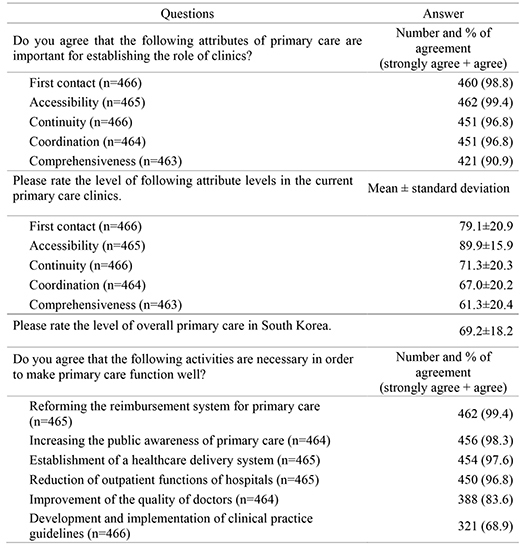1. Donaldson MS, Yordy KD, Lohr KN, Vanselow NA. Institute of Medicine (U.S.) Division of Health Care Services. Committee on the Future of Primary Care. Primary care: America's health in a new era. Washington, D.C.: National Academy Press;1996.
2. Lee JH, Choi YJ, Volk RJ, Kim SY, Kim YS, Park HK, Jeon TH, Hong SK, Spann SJ. Defining the concept of primary care in South Korea using a Delphi method. Fam Med. 2007; 39:425–431.
3. Choi YJ, Ko BS, Cho KH, Lee JH. Concept, values, current status and prospect of primary care in Korea. J Korean Med Assoc. 2013; 56:856–865.
4. Oh YH. Primary health care: current status and ways for improvement. Health Welf Policy Forum. 2010; 11:16–32.
5. Starfield B. New paradigms for quality in primary care. Br J Gen Pract. 2001; 51:303–309.
6. Starfield B, Shi L. Policy relevant determinants of health: an international perspective. Health Policy. 2002; 60:201–218.
7. Song YJ. The South Korean health care system. Japan Med Assoc J. 2009; 52:206–209.
8. Kwon S. Payment system reform for health care providers in Korea. Health Policy Plan. 2003; 18:84–92.
9. Chun CB, Kim SY, Lee JY, Lee SY. European Observatory on Health Systems Policies. Republic of Korea: health system review. Health Syst Transit. 2009; 11:1–184.
10. Kwon S. Thirty years of national health insurance in South Korea: lessons for achieving universal health care coverage. Health Policy Plan. 2009; 24:63–71.
11. Jeong H, Lee H, Lee JH, Lee T. Payment reform for the improvement of primary care in Korea. J Korean Med Assoc. 2013; 56:881–890.
13. The Organization for Economic Co-operation and Development. OECD healthcare quality review: Korea, assessment and recommendation. Paris: OECD;2012. accessed on 1 January 2014. Available at
http://www.oecd.org/korea/49818570.pdf.
14. Starfield B. Primary care : balancing health needs, services, and technology. 1998. New York: Oxford University Press.
15. Ahn SH. Assessment of primary care level in Korea and comparison with the developed countries. J Korean Acad Fam Med. 2001; 22:483–497.
16. Ock M, Kim JE, Jo MW, Lee HJ, Kim HJ, Lee JY. Perceptions of primary care in Korea: a comparison of patient and physician focus group discussions. BMC Fam Pract. 2014; 15:178.
17. Kim YI, Hong JY, Kim K, Goh E, Sung NJ. Primary care research in South Korea: its importance and enhancing strategies for enhancement. J Korean Med Assoc. 2013; 56:899–907.
18. Schäfer WL, Boerma WG, Kringos DS, De Ryck E, Greß S, Heinemann S, Murante AM, Rotar-Pavlic D, Schellevis FG, Seghieri C, et al. Measures of quality, costs and equity in primary health care instruments developed to analyse and compare primary care in 35 countries. Qual Prim Care. 2013; 21:67–79.
19. Choi YG, Kim K, Choi YJ, Sung NJ, Kim J, Park JH, Hong SK, Lee JH. Korean Primary Care Research Group. Patient assessment of primary care of health cooperative clinics in South Korea. Korean J Fam Med. 2010; 31:765–777.
20. Stange KC, Nutting PA, Miller WL, Jaén CR, Crabtree BF, Flocke SA, Gill JM. Defining and measuring the patient-centered medical home. J Gen Intern Med. 2010; 25:601–612.
21. Jo HS. Strategies for improvement of primary care in Korea. J Korean Med Assoc. 2012; 55:959–968.
22. Korea Consumer Agency. Department of Market Research Consumer Transaction Research Team. Problems and improvement approaches in hospital emergency unit utilization. Seoul: Korea Consumer Agency;2012.









 PDF
PDF ePub
ePub Citation
Citation Print
Print




 XML Download
XML Download